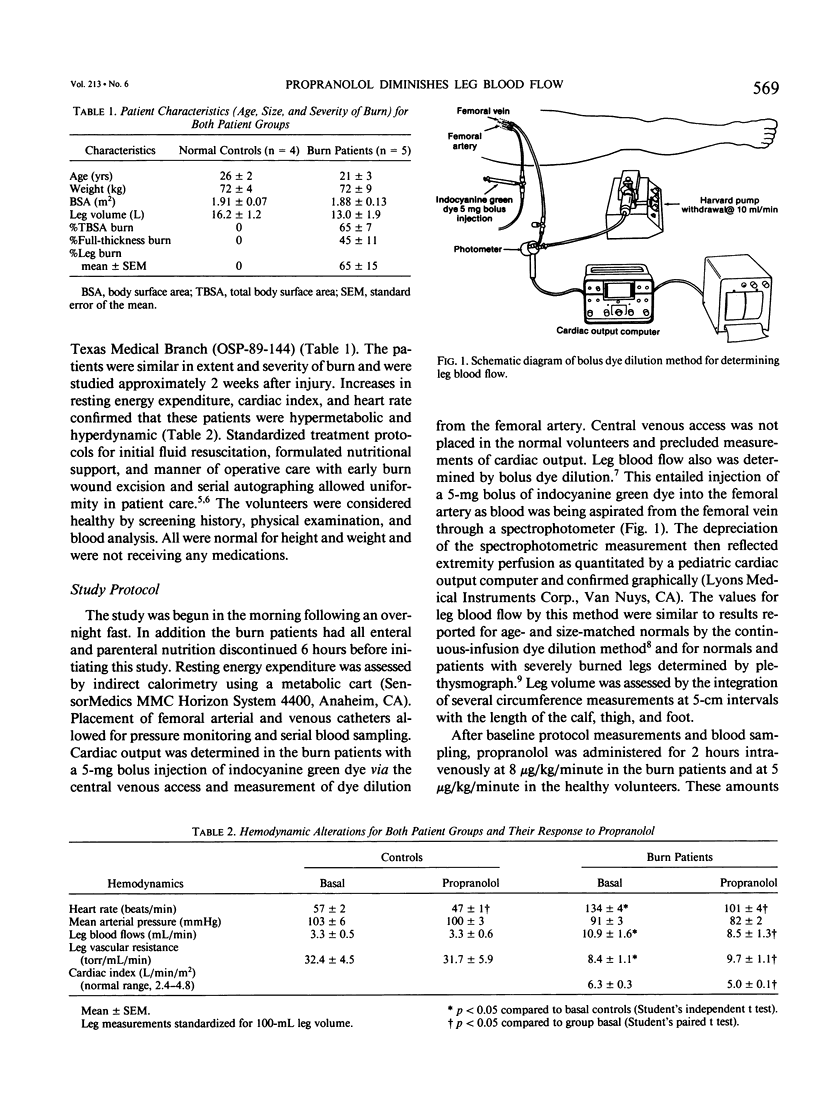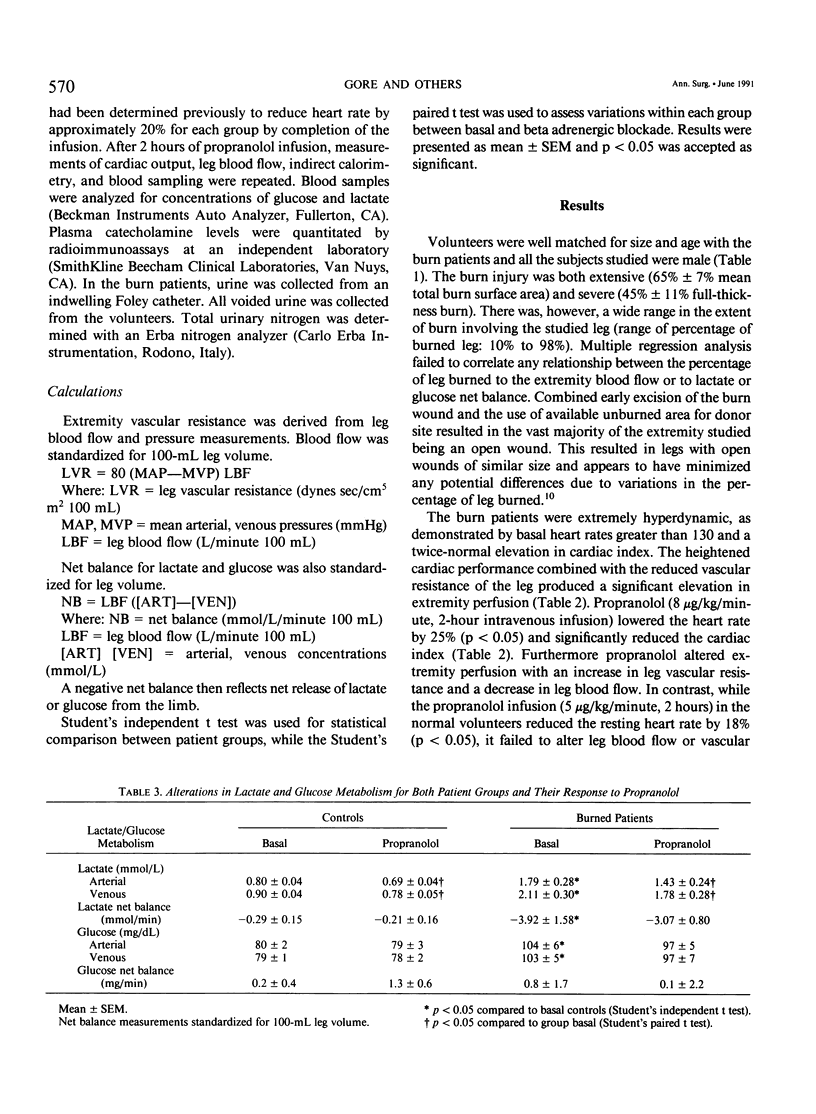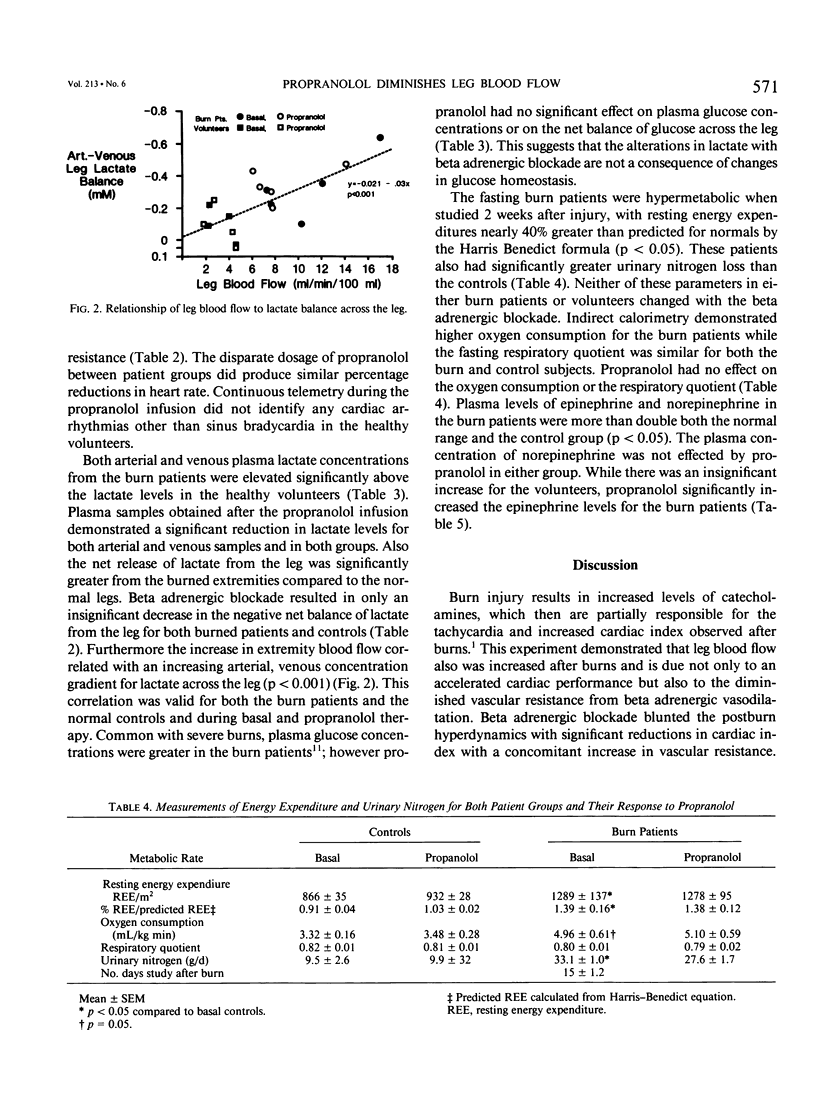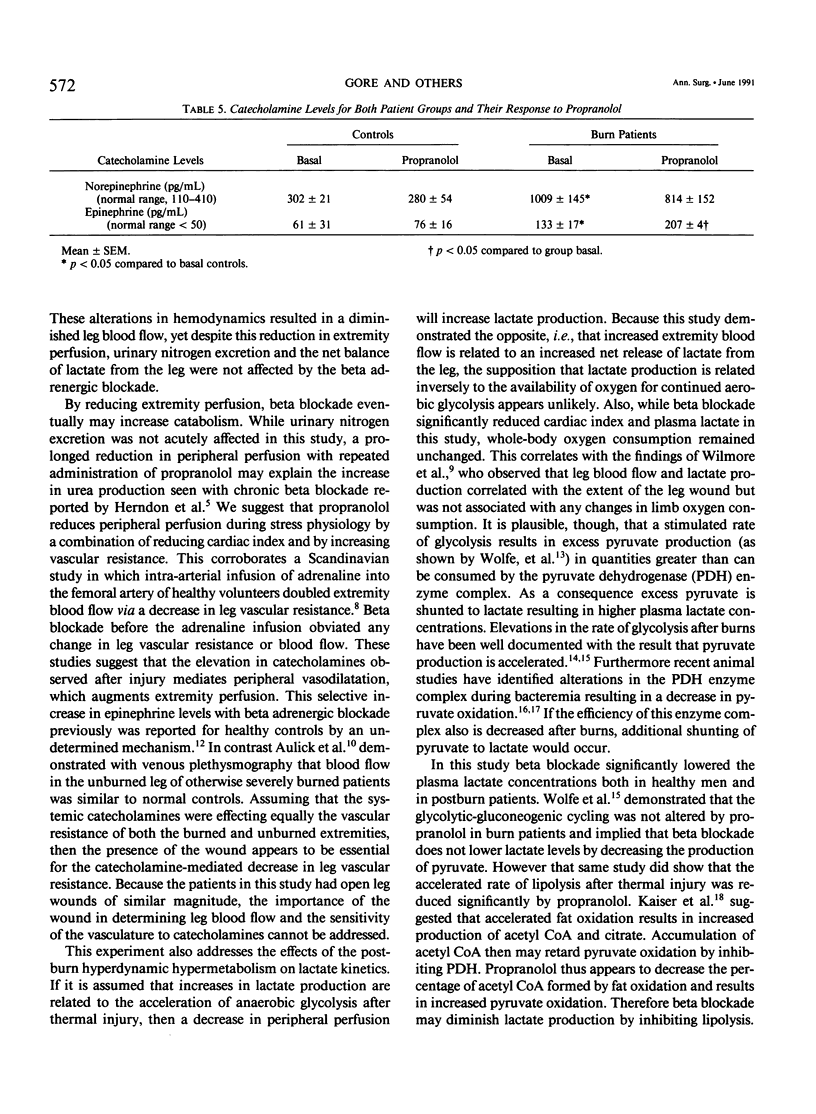Abstract
Beta adrenergic blockade diminishes the catecholamine-mediated elevations in heart rate and myocardial contractility that characterize postburn hypermetabolism. To examine how these alterations in cardiac performance affect peripheral perfusion, indirect calorimetry and leg blood flow were measured before and then after a 2-hour intravenous propranolol infusion. Five severely burned patients (55% + 7% total burn surface area), given propranolol at 8 micrograms/kg/minute, had a significant reduction in cardiac index and heart rate with an increased leg vascular resistance resulting in a decrease in extremity perfusion. Four healthy volunteers were given propranolol at 5 micrograms/kg/minute, resulting in a comparable decrease in heart rate, yet there was no change in leg vascular resistance or extremity perfusion. In both patient groups, propranolol decreased the plasma lactate concentration. This suggests that in hypermetabolic patients, beta adrenergic blockade reduces peripheral perfusion and that peripheral perfusion is not a principal determinate of plasma lactate levels. Rather adrenergic blockade appears to decrease lactate concentration as a consequence of the inhibition of lipolysis.
Full text
PDF





Selected References
These references are in PubMed. This may not be the complete list of references from this article.
- Aulick L. H., Wilmore D. W., Mason A. D., Jr, Pruitt B. A., Jr Influence of the burn wound on peripheral circulation in thermally injured patients. Am J Physiol. 1977 Oct;233(4):H520–H526. doi: 10.1152/ajpheart.1977.233.4.H520. [DOI] [PubMed] [Google Scholar]
- GOODALL M., HAYNES B. W., Jr Adrenal medullary insufficiency in severe thermal burn. J Clin Invest. 1960 Dec;39:1927–1932. doi: 10.1172/JCI104217. [DOI] [PMC free article] [PubMed] [Google Scholar]
- Goodall M., Moncrief J. A. Sympathetic Nerve Depletion in Severe Thermal Injury. Ann Surg. 1965 Nov;162(5):893–900. doi: 10.1097/00000658-196511000-00013. [DOI] [PMC free article] [PubMed] [Google Scholar]
- Gore D. C., Rutan R. L., Hildreth M., Desai M. H., Herndon D. N. Comparison of resting energy expenditures and caloric intake in children with severe burns. J Burn Care Rehabil. 1990 Sep-Oct;11(5):400–404. doi: 10.1097/00004630-199009000-00005. [DOI] [PubMed] [Google Scholar]
- Juhlin-Dannfelt A., Aström H. Influence of beta-adrenoceptor blockade on leg blood flow and lactate release in man. Scand J Clin Lab Invest. 1979 Apr;39(2):179–183. doi: 10.1080/00365517909106091. [DOI] [PubMed] [Google Scholar]
- Kaiser P., Tesch P. A., Thorsson A., Karlsson J., Kaijser L. Skeletal muscle glycolysis during submaximal exercise following acute beta-adrenergic blockade in man. Acta Physiol Scand. 1985 Mar;123(3):285–291. doi: 10.1111/j.1748-1716.1985.tb07589.x. [DOI] [PubMed] [Google Scholar]
- Lilavivat U., Brodows R. G., Campbell R. G. Adrenergic influence on glucocounterregulation in man. Diabetologia. 1981 Apr;20(4):482–488. doi: 10.1007/BF00253412. [DOI] [PubMed] [Google Scholar]
- Shamoon H., Hendler R., Sherwin R. S. Synergistic interactions among antiinsulin hormones in the pathogenesis of stress hyperglycemia in humans. J Clin Endocrinol Metab. 1981 Jun;52(6):1235–1241. doi: 10.1210/jcem-52-6-1235. [DOI] [PubMed] [Google Scholar]
- Vary T. C., Siegel J. H., Tall B. D., Morris J. G. Metabolic effects of partial reversal of pyruvate dehydrogenase activity by dichloroacetate in sepsis. Circ Shock. 1988;24(1):3–18. [PubMed] [Google Scholar]
- Wahren J., Jorfeldt L. Determination of leg blood flow during exercise in man: an indicator-dilution technique based on femoral venous dye infusion. Clin Sci Mol Med. 1973 Aug;45(2):135–146. doi: 10.1042/cs0450135. [DOI] [PubMed] [Google Scholar]
- Wilmore D. W., Aulick L. H., Mason A. D., Pruitt B. A., Jr Influence of the burn wound on local and systemic responses to injury. Ann Surg. 1977 Oct;186(4):444–458. doi: 10.1097/00000658-197710000-00006. [DOI] [PMC free article] [PubMed] [Google Scholar]
- Wilmore D. W., Long J. M., Mason A. D., Jr, Skreen R. W., Pruitt B. A., Jr Catecholamines: mediator of the hypermetabolic response to thermal injury. Ann Surg. 1974 Oct;180(4):653–669. doi: 10.1097/00000658-197410000-00031. [DOI] [PMC free article] [PubMed] [Google Scholar]
- Wolfe R. R., Durkot M. J., Allsop J. R., Burke J. F. Glucose metabolism in severely burned patients. Metabolism. 1979 Oct;28(10):1031–1039. doi: 10.1016/0026-0495(79)90007-6. [DOI] [PubMed] [Google Scholar]
- Wolfe R. R., Herndon D. N., Jahoor F., Miyoshi H., Wolfe M. Effect of severe burn injury on substrate cycling by glucose and fatty acids. N Engl J Med. 1987 Aug 13;317(7):403–408. doi: 10.1056/NEJM198708133170702. [DOI] [PubMed] [Google Scholar]
- Wolfe R. R., Klein S., Carraro F., Weber J. M. Role of triglyceride-fatty acid cycle in controlling fat metabolism in humans during and after exercise. Am J Physiol. 1990 Feb;258(2 Pt 1):E382–E389. doi: 10.1152/ajpendo.1990.258.2.E382. [DOI] [PubMed] [Google Scholar]


